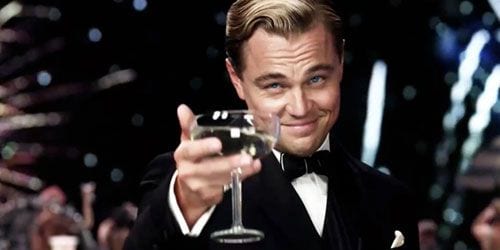
While F. Scott Fitzgerald is credited with achieving a near-perfect realization of the Great American Novel with The Great Gatsby, the book has been something of an albatross for filmmakers. Adaptation problems arose soon after is publication, starting with a 1926 movie that Fitzgerald himself famously walked out on.
Still, directors keep trying. Since the 1926 flop, as PopMatters writer John Coffey points out in Hey Old Sport (Again), the material has been fashioned into a 1949 gangster flick; a gauzy, soft-focus 1974 film; a 2000 made-for-tv movie; and, now, a Baz Luhrmann-directed 3D extravaganza.
Despite the anachronisms, director Baz Luhrmann attempts to not only stay true to the spirit of F. Scott Fitzgerald’s book, but also to the way the book was perceived in its own period. So, if jazz music was the soundtrack to youth culture of the time, it’d be, he figures, analogous to the hip-hop of today; he then loads up the film with period-appropriate jazz courtesy of the Brian Ferry Orchestra, hip-hop tracks by Jay Z (who executive-produced the movie) and his collaborators, jazzy covers of contemporary songs, and modern songs made to sound old-timey, all in varying degrees and combinations.
It’s a lot to bite off. Unfortunately, Luhrmann’s ambition doesn’t let him escape from the number-one trap that plagues any Gatsby adaptation: Fitzgerald himself. Fitzgerald’s words are so perfectly arranged, and so available, it’s tempting just to point the camera at someone reading the book word-for-word (something akin to the Elevator Repair Service’s Gatz). But Fitzgerald’s narration is best used sparingly, and Luhrmann overdoes it, to the point where the words not only describe what can plainly be seen, they appear as title cards on the screen. Worse, to give narrator Nick Carraway (the suitably boyish Tobey Maguire) someone to recite this narration to, a ridiculous framing device is invented, and becomes the source of the film’s cheesiest moments.
It’s also tempting for The Great Gatsby adaptors to go overboard with period details and, in order for Luhrmann to fit them all in – and in three dimensions theatrically (which slows down Luhrmann’s usual breakneck editing pace) – there is a reliance on CGI. Sometimes the effect is seamless; a car trip over the Queensboro Bridge gives no clues that everything outside the car is digital. Other times, though, the visuals veer into cartoonishness, especially overhead shots that show an abrupt, color-blocked disconnect between wealthy West Egg, the poorer Valley of Ashes, and Manhattan beyond, looking like three different paintings stuck together with Scotch tape.
While the connective tissue may have issues, the heart of The Great Gatsby story unfolds at three different parties that punctuate Carraway’s summer in New York, and, with these, Luhrmann delivers. This is quite possibly because the excesses of the period Fitzgerald was writing about gels perfectly with the excesses of Luhrmann’s visual style. At Gatsby’s mansion, Luhrmann packs the frame with extras in glittering Prada dresses; performers that include jazz bandleaders, bedecked dancers, wailing chanteuses, and an amped-up organist; confetti pouring from somewhere up above; and an unfathomable amount of liquor bottles and Champagne glasses. These images are incredibly immersive in the 3D theatrical release, but even flattened for the Blu-ray release, they seem all-enveloping.
You can’t dream up a better introduction to Jay Gatsby (a perfectly cast Leonardo DiCaprio) than Luhrmann’s, with fireworks and “Rhapsody in Blue” — you don’t quite see a twinkle in his teeth when he smiles, but you can imagine Nick perceiving one. These details do pop off the screen, and they do fulfill Luhrmann’s mission of looking both period-appropriate and surprisingly modern. You might admire Gatsby’s cool, beautiful wardrobe not just as a paean to its time, but enough to want to buy it today (and you can, at Fitzgerald’s preferred clothier, Brooks Brothers).
We’re told repeatedly not to admire this world and its “careless people”, but it’s hard not to gawk. If, like Nick, you just want to revel in Gatsby’s orbit, the Blu-ray provides loads of extras to better immerse you in the world, delving into the parties, the clothes, the music, and the historical context of them all. Luhrmann and his producer/production designer/costumer (and wife) Catherine Martin are extremely present in all of these features, and you get the feeling that they really enjoy explaining all of the little details that make up his film.
But The Great Gatsby isn’t just about details. It’s about people. You’d think it’d be hard for any performance to punch through all that art direction, but the assembled cast succeeds in making an impression — not just the shining DiCaprio, who fully earns his reputation as a movie star. Cary Mulligan as Daisy makes for a beautiful object of adoration, but Mulligan also embodies Daisy’s flightiness and superficiality, while Joel Edgerton is a brutal, physical Tom Buchanan. Still, no one projects the sleek, slinky Jazz Age glamour as newcomer Elizabeth Debicki, who plays Jordan Baker.
Luhrmann doesn’t always get at the inner lives of all these characters. Poor Jordan is reduced to best-friend capacity, and her relationship with Nick is barely explored. That’s the other perpetual problem with The Great Gatsby adaptations — even at 142 minutes, your favorite part from the novel has probably been cut or altered. Luhrmann sneaks in as much as he can, but even he knows there has to be a limit somewhere.
But rather than mourning what has been cut, Luhrmann’s The Great Gatsby is worth it for what he’s able to keep in: the exuberance and longing of people living out their younger and more vulnerable years in a glitzy time. This version of The Great Gatsby is for those who are all about the riotous excursions, not those looking for the privileged glimpses into the human heart.
